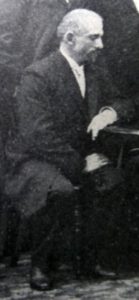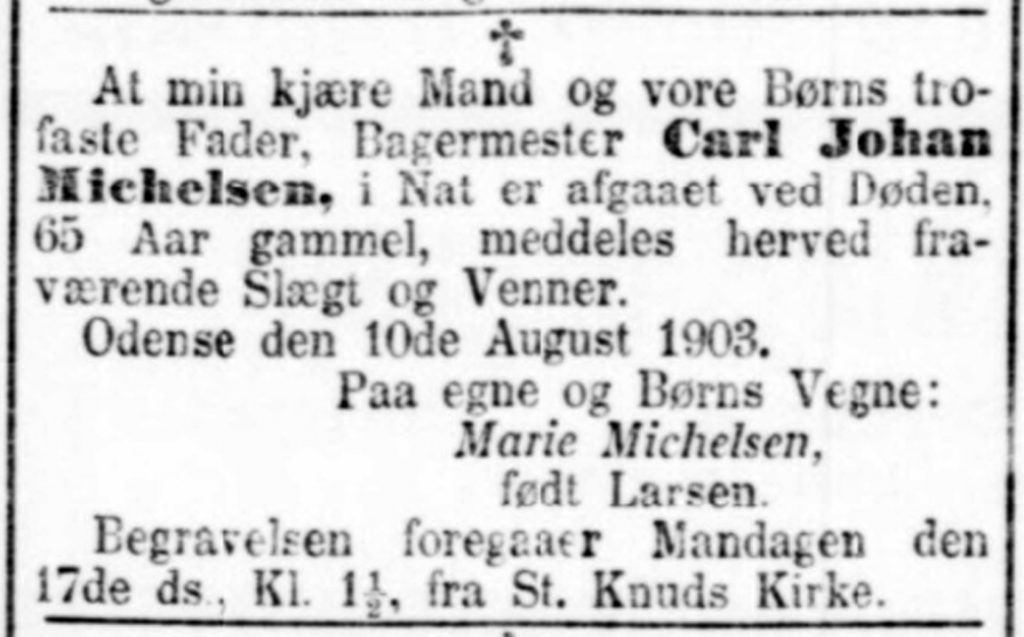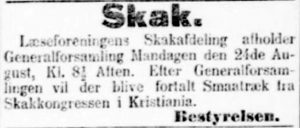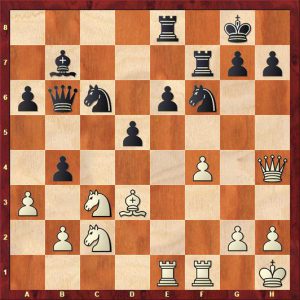Early Life of Einar Michelsen, Part 2
3rd Nordic Correspondance Tournament
Einar Michelsen’s first major event was the 3rd Nordic Correspondence Tournament, which started in November 1902. The participants were divided into two groups. Michelsen played in group A and achieved an impressive score of 3½ / 5, losing only to the favorite A. C. Rosendahl. As shown in the tournament table in Tidskrift för Schack1, it amounted to a split 2nd price and thus 70 kr. A not insignificant amount, it corresponded to approx. a weeks wage for a worker, and probably even more for Michelsen, who was still an apprentice.

Tidskrift för Schack published all of Einar Michelsen’s games:

Andreas Christian Rosendahl – Einar Michelsen2
Correspondance 1902-03
Notes by A. C. Rosendahl
1. e4 e5 2. Nc3 Nc6 3. f4 exf4 4. d4 Qh4+ 5. Ke2 g5
According to E. von Schmidt, who in his Schacheröffnungen have subjected the Steinitz gambit to a thorough investigation, black’s best defense is 5… d6 6. Nf3 Bg4 7. Bxf4 f5. The subsequent variations are indicated in Collijn’s Lärobok.
6. Nd5 Kd8 7. Nf3 Qh5 8. h4 Bh6 9. Kf2 g4
Black’s defense is mentioned by von Bardeleben, who continues with 10. Ng1 g3+ 11. Ke1 Qxd1+ 12. Kxd1 Nxd4 13. Bxf4 Bxf4 14. Nxf4 d6 believing black to be better. Von Schmidt also gives this variation in the above mentioned analysis, noting that black’s advantage is minimal. The following sacrifice is presumably new and gives white a strong attack.
10. Bxf4 gxf3
If 10… Bxf4 then 11. Nxf4 Qh6 12. Ng5 Qg7 (12… Ke8 13. Nd5) 13. e5.
11. Bxc7+ Ke8 12. gxf3 Bg7 13. c3 Nge7 14. Bc4 b5
An attempt to develop the queen side pieces; better seems 14… d6 15. Bxd6 Be6 16. Nc7+ Kd7.
15. Bb3 a6
A wasted move, black had to play 15… Bb7 immediately, or maybe 15… a5 which would have forced white’s bishop back to c2.
16. Qd2 Bb7 17. Rag1 Ng6 18. Nf4 Bh6
If 18… Qh6 then 19. Rg5 Bf6 20. Nh5 Bxg5 21. hxg5 Qf8 22. Nf6+ Ke7 23. e5.
19. Nxh5 Bxd2 20. Nf6+ Ke7 21. Nd5+ Ke8 22. Nb6 Ra7
By offering the exchange by playing 22… Bh6 black would still have been able to defend himself.
23. h5 Nf4
If 23… Nf8 then 24. d5, and if 23… Nge7 24. Rg7.
24. d5 Nb4 25. cxb4 Bc8 26. Bd6 Kd8 27. Rg4 Nd3+ 28. Ke2 Bxb4 29. Bxb4 Nxb4 30. d6
And black resigned, as the threatening Rhg1 cannot be parried.
1-0
The game finished February 13, 1903.
Andreas Christian Rosendahl (1864-1909), a bookkeeper from Copenhagen, was one of the strongest Scandinavian players of his time. He was 4th in the Nordic championship 1897, and shared 3rd two years later. He was founder and editor of Tidsskrift for Skak (later Tidskrift för Schack) 1894-1901. Contracted tuberculosis and died relatively young.
Edvard Mortensen – Einar Michelsen3
Correspondance 1902-03
Notes by Fritz Englund
1. e4 e5 2. Nc3 Nf6 3. f4 d5 4. fxe5 Nxe4 5. Nf3
White can even play 5. Qf3 f5 6. d3 Nxc3 7. bxc3 d4 8. Bd2 etc.
5… Bb4 6. Qe2
6. Be2 is a more energetic continuation. After 6… c6 7. 0-0 Qb6+, which is indicated in Collijn’s Lärobok, white gets a very strong attack after 8. d4 Nxc3 9. bxc3 Bxc3 10. Ba3 Bxa1 11. Qxa1.
6… Bxc3 7. dxc3 f6
Collijn’s Lärobok gives von Schmidt’s 7… 0-0. The text move is hardly an improvement.
8. Bf4
Better seems 8. exf6 Qxf6 9. Bg5 followed by 0-0-0. Or 8… 0-0 9. fxg7 Re8 10. Be3 c5 11. Qd3 d4 12. 0-0-0 etc.
8… 0-0 9. c4 Bf5 10. 0-0-0 c6 11. cxd5 Qa5
12. dxc6?
After 12. d6 Qxa2? 13. Qc4+ Qxc4 14. Bxc4+ etc. or 12… fxe5 13. Qc4+ Kh8 14. Nxe5 etc. white seems to keep the pawn with good play.
12… Nxc6 13. Qc4+ Kh8 14. exf6 Rxf6 15. Ng5 Nf2 16. Nf7+
On 16. Bd2 white loses an exchange after 16… Qc7. However, this was preferable as a piece is lost after the text move.
16… Rxf7 17. Qxf7 Nxd1 18. Kxd1 Bg4+ 19. Be2
White is of course forced to block with the bishop.
19… Rd8+ 20. Kc1 Bxe2 21. Kb1 Nb4
22. Bh6!
An interesting move. If the bishop is taken, white has perpetual check.
22… Qe5 23. Qxb7 Nxc2
23… Rb8? 24. Bxg7+

24. Bxg7+ Qxg7 25. Qxg7+ Kxg7 26. Kxc2 Rf8! 27. Rg1
If 27. b4 then 27… Rf2 28. Rg1 Bf3+. Or if 27. g3 Rf2 28. Kc3 Bf3 etc.
The following endgame is quite instructive.
27… Rf1 28. Rxf1 Bxf1 29. g3 Kf6 30. Kd2 Kf5 31. Ke3 Kg4 32. b4 Bb5 33. a3 a6 34. Ke4 h5 35. Ke5 Kh3 36. Kf4 Kxh2 37. Kg5 Kxg3 38. Kxh5 Kf4 39. Kh4 Ke4 40. Kg3 Kd3 41. Kf2 Kc3 42. Ke3 Kc2 43. Ke4 Kb2 44. Kd4 Kb3 45. Ke3 Kxa3 46. Kd2 Kb2!
The king cannot take the pawn immediately as the white king then reaches the corner square and the game would then be a draw.
47. Kd1 Ba4+ 48. Ke2
If the king goes to d2, Bc2 follows.
48… Kc3 49. resigns
0-1
Edvard Mortensen, a bank clerk from Copenhagen. Had a degree in economy from the University of Copenhagen.
The next two games are annotated by Michelsen himself.
Einar Michelsen – Viktor Helmer Fahlander4
Correspondance 1902-03
Notes by Einar Michelsen

1. e4 c5 2. Nf3 Nc6 3. d4 cxd4 4. Nxd4 Nf6 5. Nc3 e5
The usual and probably stronger is 5… e6. In game no. 1157, Tidskrift för Schack 12/1903, white played 5… e5 6. Ndb5 and got a better position than in this game. (Referring to a game from the same tournament, Jonsson-Fahlander, which continued 6… a6 7. Nd6+ and white went on to win.)
6. Nxc6 bxc6 7. Bc4 Bb4 8. Bg5?
A lost tempo. Better was 8. Bd2. Now black goes on the offensive.
8… Qa5 9. Bd2 d5 10. exd5 cxd5 11. Bb5+
Of course, white cannot take on d5.
11… Bd7 12. Bxd7+ Nxd7 13. a3
White cannot take on d5 here either, because of 13… Qxd5 14. Bxb4 Qe4+.
13… Bxc3 14. Bxc3 Qb5 15. Qe2?
Better was 15. Qh5.
15… Qxe2+ 16. Kxe2 d4 17. Ba5 Rb8 18. b4 Rc8 19. Rac1 O-O 20. Rhd1 Rc3 21. b5 Rc4 22. Rd3 Rfc8 23. Kd2 Nc5 24. Rh3
24… f5!
Threatening 25… Ne4+ 26.Ke2 Rxc2+ 27. Rxc2 Rxc2+ 28. Kd3 Ra2.
(The editor of Tidskrift för Schack, Fritz Englund, added a couple of comments to the game. He gave black’s last move a question mark, and wrote: 24… d3 wins the exchange and the game in a couple of moves.)
25. Kd1 g6 26. Be1 e4 27. Ra1 h5 28. Ra2 d3 29. Bd2 dxc2+ 30. Rxc2 Nd3 31. Rxc4 Rxc4 32. Ke2 Rc2
Looks good, but white has a small surprise.
33. Rxd3! exd3+ 34. Kxd3 Rc7!
Better than 34… Ra2 when 35. Bb4 Rxf2 36. Bc5! follows.
35. Bf4 Rc8 36. a4 Kf7 37. a5 Ke6 38. Be3 Rc7 39. b6 axb6 40. axb6 Rb7 41. Kc4 f4 42. Bd4 Kd6 43. Kb5 Rf7 44. Bc5+ Kd5 45. h4 f3 46. gxf3!
If white plays 46. g3 the game is a draw.
46… g5
Black can’t take on f3 because 47. b7 Rb3+ 48. Bb4 follows.
(Englund claimed that 46… g5 was the losing move.)
47. hxg5 h4
Now a quite interesting endgame follows.
48. Be3
Threatening 49. g6 Rxg7 50. Bf4!
48… Ke5
(Black could in fact have saved the game at this late stage after 48… h3 49. g6 h2! 50. gxf7 h1=Q 51. f8=Q Qf1+! and white cannot escape the perpetual check.)
49. Kc6 Kf5 50. b7 Rxb7 51. Kxb7 h3 52. g6 h2 53. g7 h1=Q 54. g8=Q Qb1+ 55. Kc6 Qc2+ 56. Kd6 resigns
1-0
Viktor Helmer Fahlander (1866-1948), an adjunct professor from Östersund, Sweden. Mainly a correspondance player and problem composer, but participated in his only international over-the-board tournament in Stockholm 1905, where he played Michelsen again.
Helmer Pettersson – Einar Michelsen5
Correspondance 1902-03
Notes by Einar Michelsen
1. e4 e5 2. Nf3 Nc6 3. Bc4 Nf6 4. d4 exd4 5. O-O Nxe4 6. Re1 d5 7. Bxd5 Qxd5 8. Nc3 Qd8 9. Rxe4+ Be7 10. Nxd4 O-O
Regarding the opening see Collijn’s Lärobok i Schack, second edition.
11. Nxc6 bxc6 12. Bf4 Bf5 13. Rd4 Qb8 14. Na4 c5 15. Rd2
This move gives black an advantageous pawn exchange.
15… Qb4 16. c4 Qxc4 17. Bxc7 Rac8 18. Ba5 Bf6 19. b3 Qh4 20. Bc3 Bxc3 21. Nxc3 Rc6
To play for the attack, though white quickly stops this.
22. Rd6 Rxd6 23. Qxd6 Qd4 24. Qxd4 cxd4 25. Nd5 Re8 26. f3 d3 27. Rd1 Re2 28. Kf1 Kf8 29. g4! Be6!
If 29… Bg6 then 30. h4! follows.

30. Nc3 Rxh2 31. Rxd3 Ke7 32. Re3 Kd6 33. Ke1 Kc6 34. Ne2 Kc5 35. Kd2 Bd5!
Threatening to win a pawn by Kb4 or Rf2.
36. Kc3 Rf2 37. f4 Rf3
Black can’t play 37… Bf3 because of 38. Nc1, but the text move wins another pawn and the game.
38. b4+ Kb6 39. Kd4 Rxe3 40. Kxe3 Bxa2 41. Kd4 f6 42. resigns
0-1
Helmer Pettersson, Älvdalen, Sweden. Participated in the Nordic championship 1901, but placed last in the 2nd class tournament. Not to be confused with the stronger A. H. Pettersson, who won the Nordic championship in 1905.
Einar Michelsen – Herman Jonsson6
Correspondance 1902-03
Notes by Herman Jonsson
1. e4 e6 2. d4 d5 3. Nc3 Nf6 4. Bg5 Be7 5. e5 Nfd7 6. Bxe7 Qxe7 7. Nb5 Qd8 8. Bd3?
A mistake that costs a pawn. 8. c3 is the best continuation.
8… a6 9. Na3 c5 10. f4 Qa5+ 11. c3 cxd4 12. Ne2 dxc3 13. Nxc3 b5 14. Qd2
The only way to prevent the loss of a piece. If 14… b4 then 15. Ne2 can follow now.
14… Nc6 15. Nc2 0-0 16. 0-0 f6 17. exf6 Nxf6 18. a3 Bb7 19. Qf2 Rae8 20. Qh4 Rf7 21. Rae1 Qb6+ 22. Kh1 b4
The intention of this move is to 23. axb4 Nxb4 24. Nxb4 Qxb4 25. Re2 e5! and then let the two passed central pawns move further up the board.
However, the move should have been preceded by 22… g6 as white’s following bold attack nullifies the plan.
23. Nxd5!
Now black has other things to worry about and must defend pretty much for the rest of the game.
23… Nxd5
To take with the pawn would of course be deadly.
24. Qxh7+ Kf8 25. Bg6 Nf6 26. Qh8+ Ke7 27. Qh3 Kf8 28. Ne3
White should have checked on h8 again and then returned to h3 with the queen, because a draw seemed less satisfactory at this stage. I was ready to move the bishop from the good square on b7 to c8 to cover e6, and then it’s just sink or swim.
28… Kg8 29. Nc4 Qd4 30. Ne5 Rfe7 31. Re3
White doesn’t care about the exchange but continues to play for the attack, which is probably the right thing to do.
31…Rd8 32. Bc2
Stops the queen from going to d1 and threatens to attack e6 again.
32… Qxb2 33. Bb3 Nxe5
It is doubtful as to whether this is the best move. The position is so complicated that it is difficult to navigate the maze. If 33… Nd4 then 34. Nc4 and to save the queen black must sacrifice his bishop on g2.
34. fxe5 Nd5 35. Re4 Nc7
The rook threatened to go to h4, which is now parried by Bxg2+.
(Black wins easily after 35… Qc3! 36. Qxc3 (forced) bxc3 and there is no compensation for the piece.)
36. Rxb4! Bxg2+
This sacrifice is forced. Other moves, for example Qe2 or Qxe5 would only worsen the situation.
37. Qxg2 Qxa3 38. Qe4 Nd5 39. Bc2 Qh3 40. Rf3 Qh6 41. Rb1 Rc7 42. Rg1 Rdc8 43. Bd3 Rc1 44. Rff1 Rxf1 45. Rxf1 Rc1
Hereby, an exchange is lost but there is hardly any better resort from the threatening Qf3-Qf7+-Qf8+ and Rf8 mate.
46. Qh7+!
A beautiful move … and the only salvation! If 46. Bxa6 Rxf1+ 47. Bxf1 Qf4 48. Qxf4 Nxf4 followed by Ng6 and Nxe5 gives black winning chances.
46… Qxh7 47. Bxh7+ Kxh7 48. Rxc1 Nf4
If 48… Kg6 then 49. Rg1+ Kf7 50. Kg2 etc.
49. Ra1 Kg6 50. Rxa6 Kf5 51. Ra5 g5 52. Kg1 Nd3 53. Kg2 Kf4 54. Ra6 Kxe5 55. Kg3 Kf5 56. Ra8 Ne5 57. h3 Ng6 58. Rg8 e5 59. Rg7 e4 60. Kf2 Nf4 61. Ke3 Nxh3 62. Rf7+ Ke5
1/2-1/2
Herman Jonsson (1860-1936), a farmer from Partille near Gothenburg, Sweden. He specialized in problem composing, but also played correspondence and over-the-board chess. Played in the Nordic championship 1905 in 1st class, but only gathered three draws in 10 games. A diligent writer, he penned chess columns in a number of Swedish newspapers and magazines. In his later years he became a local politician, a judge, and even wrote and published a selection of his poems at the age of 74!

Kristiania 1903
Einar Michelsen’s first international over-the-board tournament took place in Kristiania (now Oslo), Norway, August 9-21, 1903. It was the biannual congress of the Nordic Chess Federation, which invited participants from Denmark, Sweden and Norway, and at the general meeting Finland was also enrolled in the federation. Michelsen participated in the 2nd class tournament.
Michelsen’s journey to Norway was probably by train via Copenhagen and Malmö as all other Danish players and officials were from Copenhagen.
The Danish delegation arrived at Kristiania railway station on Sunday afternoon, August 9, and was received by the tournament committee from Kristiania’s Chess Society with organizer Svend Vaage at the forefront. First the group went to Centralhotellet where all the foreign guests stayed, and then to the playing hall at Studentersamfundet, located at 26 Universitetsgaden. The Nordic Chess Federation held a conference at 6 p.m. with subsequent dining in the St. Hanshaugen quarter. The players retired early to be ready for next morning’s games.7

Playing time was 10 a.m. – 2 p.m. with adjournments from 5 p.m. Time control was 2 hours for 30 moves and then 15 moves an hour. The games would start at the sound of organizer Svend Vaage’s gong.
There were 4 prizes in the 2nd class, 100 kr., 75 kr., 50 kr., and 20 kr.

Monday, August 10
The 1st day of play started with a player meeting at 9.30 a.m., where lots were drawn for both groups, and the round began promptly at 10 a.m.
Round 1:
Gustaf Nyholm – Einar Michelsen, Ruy Lopez, 0-1 (the game was adjourned, play was resumed at 5 p.m. and finished at 5.15 p.m.)
T. Kjølstad – M. H. Moe, 1-0
D. Muus – L. Lassen, ½-½
J. Lundgren, bye
It has not been possible to find any of Michelsen’s games from this tournament. All games were the property of the Nordic Chess Federation, and could only be published in its official magazine, Tidskrift för Schack. A special issue was published with all the games from the 1st class, but unfortunately none from the 2nd.
Tuesday, August 11
Round 2:
Michelsen had a bye.
L. Lassen – G. Nyholm, 0-1
J. Lundgren – T. Kjølstad, 0-1
M. H. Moe – D. Muus, 1-0
Michelsen had the day off. Politiken wrote:
The spare time is used in the best way possible by the combatants for excursions in the beautiful surroundings or for boat and sailing trips on the Kristiania fjord.8
Wednesday, August 12
Round 3:
Einar Michelsen – L. Lassen, King’s Gambit, 0-1 (the game finished at 12.17 p.m.)
D. Muus – J. Lundgren, ½-½
G. Nyholm – M. H. Moe, 0-1
T. Kjølstad, bye
Thursday, August 13
Round 4:
M. H. Moe – Einar Michelsen, Sicilian, 1-0 (the game was adjourned, play was resumed at 5 p.m. and finished at 6.40 p.m.)
T. Kjølstad – D. Muus, 0-1
J. Lundgren – G. Nyholm, 0-1
L. Lassen, bye
A local paper, Aftenposten, published this the next morning:
Hr. Michelsen, a sympathetic young man who has already gained a lot of attention, yesterday received the sad news that his father had died. He will, however, participate in the tournament until Saturday, but it has been arranged that a game that he was supposed to play on Sunday will be played tomorrow evening.9
From a death notice in Fyens Stiftstidende, August 12, it appears that Michelsen’s father died already on August 10, 3 days before the message reached Norway. One could suspect that Michelsen first learned about the death by reading the notice in the paper. The funeral was scheduled for Monday and he therefore had to embark on the journey home already on Saturday.

Friday, August 14
Before the start of the 5th round, a photographer visited the playing hall. Michelsen is sitting at the second table from the right and turns halfway around to look into the camera.

Round 5:
Einar Michelsen – J. Lundgren, Vienna, ½-½ (the game finished at 1.10 p.m.)
L. Lassen – M. H. Moe, ½-½
G. Nyholm – T. Kjølstad, 1-0
D. Muus, bye
Round 7:
Einar Michelsen – D. Muus, Ruy Lopez, 1-0 (the game started at 5 p.m. and finished at 7.35 p.m.) This was the game played in advance.
Saturday, August 15
Round 6:
T. Kjølstad – Einar Michelsen, Queen’s Gambit Declined, 0-1 (the game finished at 1.20 p.m.)
J. Lundgren – L. Lassen, 1-0
D. Muus – G. Nyholm, 0-1
M. H. Moe, bye
Epilogue
Michelsen began his home journey in the evening and his father’s funeral took place two days later in St. Knud’s Church in the centre of Odense, at 1.30 p.m.
Later that day, the last games of the tournament was played, and Michelsen could note that he had won 3rd prize and 50 kr.
The last games from round 7:
L. Lassen – T. Kjølstad, 1-0
M. H. Moe – J. Lundgren, 1-0
G. Nyholm, bye
A dramatic trip for the young Einar Michelsen. He subsequently sent a telegram to the tournament committee at the end of the congress on Friday, August 21.10 The content of the telegram is not known, but he likely thanked the committee for help in connection with his father’s death.
A few days later, Monday, August 24, Michelsen held a lecture about his experiences in Norway for members of his own chess club, Læseforeningen’s Chess Department.

After this, Einar Michelsen disappeared from the chess world for almost a year. Part 3 of the series will discuss this and his reappearance in 1904.
- Tidskrift för Schack 1/1904 p. 2
- Tidskrift för Schack 5/1903 pp. 108-109
- Tidskrift för Schack 10/1903 pp. 186-188
- Tidskrift för Schack 1/1904 pp. 12-13
- Tidskrift för Schack 1/1904 pp. 13-14
- Tidskrift för Schack 5/1903 pp. 109-110
- Dagens Nyheder, August 13, 1903 & Politiken, August 14, 1903
- Politiken, August 18, 1903
- Aftenposten, August 14, 1903
- Tidskrift för Schack 8/1903, p. 10









